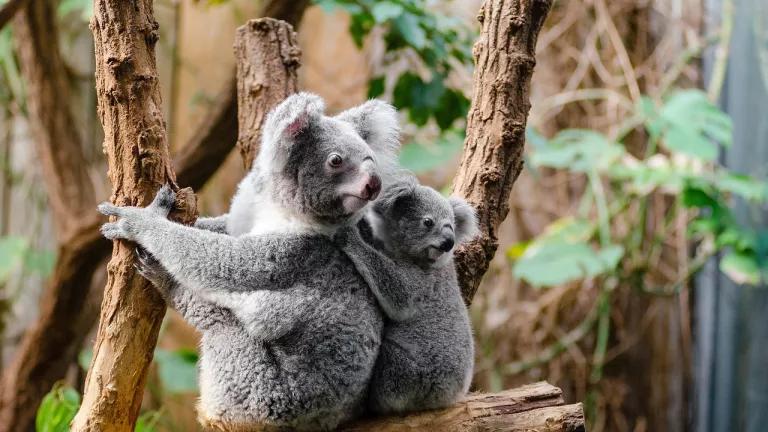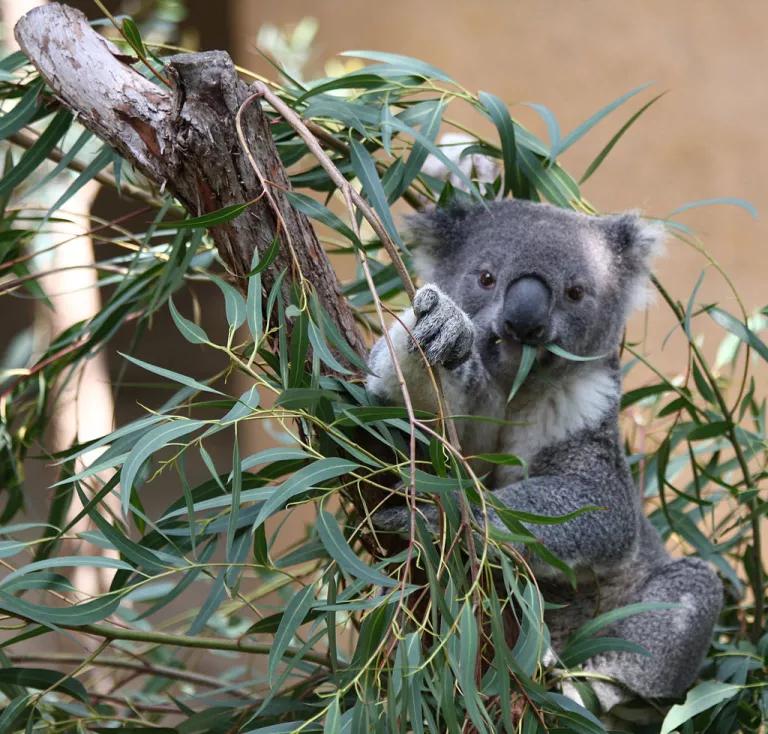Can a Chlamydia Vaccine Save Koalas?
Australia’s resident cuties are falling victim to a gruesome disease—but habitat loss is the real culprit.

The koala is a strong candidate for the most darling critter on earth. It has mad-scientist ear floofs, a dopey nose, and the rounded body dimensions of a teddy bear. But chlamydia is not cute. The contagious bacterial disease gums up the koala’s eyes with mucus, damages its kidneys, and thickens its bladder, making the animal cry out in pain each time it tries to pass blood-streaked urine.
Unfortunately, chlamydia is spreading through Australia’s koalas like wildfire. A 2013 study estimates that around 50 percent of the koala population is infected—terrible news for a creature considered vulnerable to extinction by the International Union for Conservation of Nature. (There is ongoing debate about how many koalas remain in Australia; some sources estimate up to half a million animals while others put the number as low as 45,000.)
Koalas contract “the clap” the same way humans do (though different bacterial strains infect the two species). Chlamydia passes between koalas sexually, as well as from mother to infant during birth or nursing. And while chlamydia is a common enough and easily curable in humans, for the koala the infection can lead to blindness, tumor growth, infertility, and death.
“The cysts in females are horrifying,” says Anika Lehmann, cofounder of Moreton Bay Koala Rescue Inc., located near Brisbane. Sometimes sonograms reveal ovarian cysts the size of oranges—no small thing in an animal about the size of a three-year-old human.
The situation is no better if you drive six hours down Australia’s eastern coast. Cheyne Flanagan, the clinical director of the Koala Preservation Society Australia in Port Macquarie, says chlamydia is the number one problem they deal with at the society’s Koala Hospital. Healthy koalas spend their days in the treetops, but the bacteria and accompanying maladies sap them of the strength they need to climb. Once grounded, the animals typically either starve to death or are hit by cars or attacked by dogs. The lucky ones get picked up and brought to a rescue organization.
Still, by the time most of the sick reach Lehmann or Flanagan, it’s already too late. The best available medical treatments can usually save the koala only during the early stages of infection—when most are still strong enough to be in the treetops. And the same antibiotics that help fight off chlamydia kill some of the stomach microbes koalas rely on to digest eucalyptus, which is basically the only thing these animals eat.
“There is a point of no return,” says Flanagan. “We euthanize a lot of chlamydia cases as they are beyond help. It’s far kinder.”
Nobody knows exactly where these chlamydia strains originated or when they crossed into koalas, though it’s thought one of them may have come from cattle and sheep introduced to the continent with European colonization some 300 years ago. In any event, the pathogen is now infecting koalas all across their native range.
But all is not lost. Scientists at the University of the Sunshine Coast have spent the last seven years trying to develop a chlamydia vaccine for koalas. According to Peter Timms, the researcher spearheading the effort, his team has completed eight vaccine trials on 100 koalas (both wild and captive) without seeing any adverse effects from the jabs. They’ve also found evidence that the vaccine produces an immune response in both males and females, can be safely injected into already infected koalas, and is effective against more than one chlamydia strain. It’s still relatively early, of course, but Timms calls the recent advances exciting. “Getting close now,” he wrote in a brief email.
Not everyone is as optimistic. While Deborah Tabart, chief executive officer of the Australian Koala Foundation, holds Timms in high regard, she doesn’t think a vaccine will solve the koala’s real problem: habitat destruction.

Part of the reason the disease is running rampant is that too many koalas are being confined to smaller habitat areas. You see, eucalyptus trees are both the koalas’ dinner and their digs. In the best conditions, the marsupials will switch among nearly 20 species of eucalyptus as the trees go through cycles of new growth, flowering, and seed. But as the number of available tree species declines, so too does the number of koalas in a given area. And when pickings really get slim, Tabart says, you start to see chlamydia infections going up.
“We know that the rate of the rise on chlamydia is a result of the animals being sick, because they’re starving to death,” says Tabart.
In addition to eucalyptus forests being razed by timber and mining companies, some parts of Australia are experiencing a development boom. Southeastern Queensland, for instance, is growing by 1,000 residents a week. With population growth comes more houses, shopping malls, and roads, which means fewer trees and, eventually, fewer koalas.
According to Lehmann, the clearing of food trees for development is causing local koala extinctions. “At the moment in Queensland, more than three football fields of habitat is being cleared every minute,” she says. “This is worse than the deforestation in Brazil or Malaysia!”
For this reason, Tabart believes the koala’s only hope is new, tougher laws. She says she spent 12 years of her life trying to convince the Australian government that koalas required federal protection, which they eventually received in 2012. Even so, she says little has changed. (The government was supposed to complete a koala recovery plan in 2014, but it remains unfinished.) The listing protects koalas in name only because it fails to protect the trees they require. And if the koalas have nowhere to live and nothing to eat, she says, it won’t really matter if we find a cure for their STD.
“I think we’re on the brink of losing this species,” says Tabart.
The thing is, if Australia’s lawmakers made a real effort to protect koalas, they could do a lot of good in a single stroke. According to Tabart’s foundation, of the 1,700 other species awaiting management plans as of 2012, around 1,000 of them share habitat with the living teddy bears. This means a safe harbor for koalas could also benefit scores of other species—from flying foxes and sugar gliders to carpet pythons and kookaburras.
What Tabart wants to see for Australia is a Koala Protection Act modeled after the United States’ very own Bald and Golden Eagle Protection Act. That is, she says koalas need a piece of legislation that makes it illegal to touch them and their habitat.
“Until you get that,” she says, “everything else is fiddling while Rome burns.”
This article was originally published on onEarth, which is no longer in publication. onEarth was founded in 1979 as the Amicus Journal, an independent magazine of thought and opinion on the environment. All opinions expressed are those of the authors and do not necessarily reflect the policies or positions of NRDC. This article is available for online republication by news media outlets or nonprofits under these conditions: The writer(s) must be credited with a byline; you must note prominently that the article was originally published by NRDC.org and link to the original; the article cannot be edited (beyond simple things such grammar); you can’t resell the article in any form or grant republishing rights to other outlets; you can’t republish our material wholesale or automatically—you need to select articles individually; you can’t republish the photos or graphics on our site without specific permission; you should drop us a note to let us know when you’ve used one of our articles.

Biodiversity 101
Women Are Leading the Charge to Save the Philippines’ Last Frontier
Jair Bolsonaro to a Horrified World Community: “The Amazon Is Brazil’s, Not Yours”